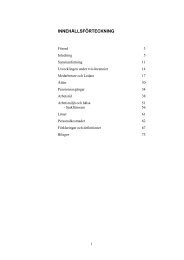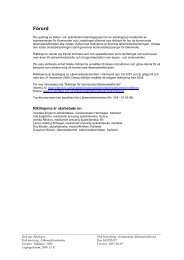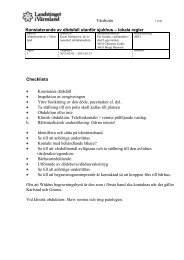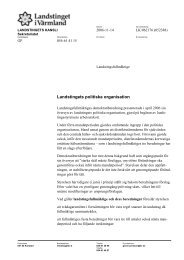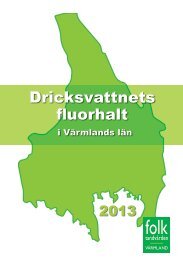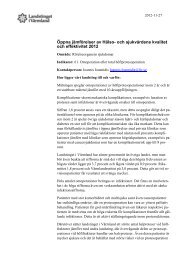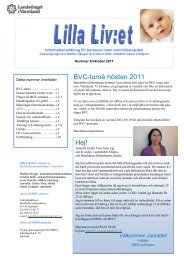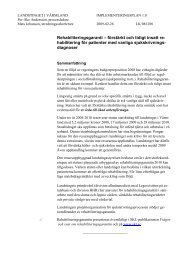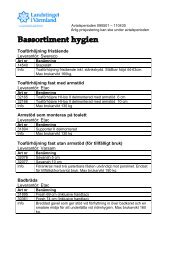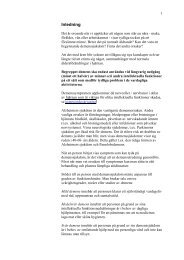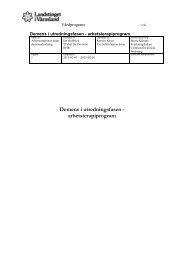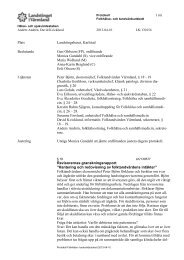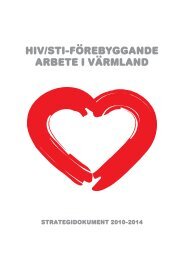Severs skada – paradigmskifte gällande diagnostik och behandling?
Severs skada – paradigmskifte gällande diagnostik och behandling?
Severs skada – paradigmskifte gällande diagnostik och behandling?
You also want an ePaper? Increase the reach of your titles
YUMPU automatically turns print PDFs into web optimized ePapers that Google loves.
daytime is sometimes recommended (Ogden et al.,<br />
2004; Kasser, 2006). Our previous study showed that<br />
two specific types of insoles, with different approaches<br />
to microtraumatic stress, were effective in<br />
relieving pain among physically active boys (Perhamre<br />
et al., 2009). By lifting the heel 5 mm with<br />
the wedge, the tension forces are expected to be<br />
reduced in mid stance and in push off. The heel cup<br />
is thought to act as an internal tight box in the shoe,<br />
fixating the heel pad in order to reduce the direct<br />
impact force in heel strike.<br />
The purpose of this study was to test which of the<br />
two insoles, the heel wedge or the heel cup provided<br />
best pain relief in boys with Sever’s injury, without<br />
reducing their level of physical activity.<br />
Materials and methods<br />
The study was a prospective crossover designed, with alternation<br />
between baseline phases and intervention phases with the<br />
two different insole alternatives (Fig. 1). The first randomized<br />
part of the study period included 12 weeks. In the second nonrandomized<br />
part of the study (14 weeks), each boy chose one<br />
treatment alternative (Fig. 2).<br />
Inclusion criteria were male between 9 and 15 years with a<br />
history of Sever’s injury, and heel pain present for 42 weeks,<br />
but o26 weeks when examined. Findings confirming the<br />
diagnosis were tenderness over the calcaneal tubercle, and a<br />
positive compression test (Kasser, 2006). Additional negative<br />
test results from the Achilles tendon were compulsory. The<br />
level of physical activity must be high, at least the second<br />
highest level of sport activity (D 5 strained to shortness of<br />
breath and sweating many times a week or E 5 strained to<br />
Fig. 1. The heel wedge used in the study, lifting the heel<br />
5 mm and the heel cup (of 3 mm. thickness) fixating the heel<br />
pad. The cup offers no wedge effect, due to equal lift of the<br />
rear and fore foot.<br />
42<br />
shortness of breath and sweating every day or most days of the<br />
week) according to Engstro¨ m’s activity index (Engstro¨ m,<br />
2004).<br />
Two alternative insoles, the heel wedge and the heel cup,<br />
were used (Fig. 1). Bilateral treatment was always performed.<br />
The heel wedge was a 5 mm cork wedge covered with a thin<br />
elastic surface. It lifted the heel 5 mm in mid stance and push<br />
off. The heel cup was a rigid thermoplastic cup (of 3 mm height<br />
but with no wedge effect) molded directly on the bare heel with<br />
a three-fourth length arch support. It enclosed the heel with a<br />
2<strong>–</strong>3 cm high brim in order to stop the heel pad from excessive<br />
deformation. The high brim made it different from earlier<br />
described molded heel insoles with their purpose to align the<br />
foot in running. There are some similar rigid alternatives, like<br />
the prefabricated Whitman<strong>–</strong>Roberts and the semi-molded<br />
Lange insoles in hard plaster.<br />
All boys were examined by the first author at the Sports<br />
Medicine Clinic for heel pain and recruited during February<strong>–</strong><br />
June during 3 following years, totally 15 months. A total of 51<br />
boys were invited of which four did not accept. During the<br />
study, three boys dropped out, one due to social complications,<br />
one due to difficulties filling in the questionnaire and one<br />
due to a calf muscle strain injury, leaving 44 boys. The<br />
analyses below were performed on data supplied by these 44<br />
boys who completed the study. Nineteen (43%) of the boys<br />
were diagnosed with unilateral Sever’s injury (10 right foot,<br />
nine left foot) and 25 with bilateral.<br />
After inclusion, the boys were randomized into two groups<br />
with tickets concealed in a box. No stratification was made.<br />
Thereafter, the pain questionnaire was filled in for the chosen<br />
activities during the baseline phase (weeks 1<strong>–</strong>2) preceding the<br />
interventions, including six registrations for each of the two<br />
activities. During the first intervention phase (weeks 3<strong>–</strong>6), the<br />
boys were using either heel cup (n 5 20, group I) or heel wedge<br />
(n 5 24, group II) including eight pain registrations for each of<br />
the two activities A and B. A second baseline phase (wash-out)<br />
followed (weeks 7<strong>–</strong>8) without any treatment. During the<br />
second intervention phase (weeks 9<strong>–</strong>12), there was a shift<br />
between insoles (crossover). In the second and final part of the<br />
study (after 12 weeks), the boys started with another baseline<br />
phase (wash-out) of 2 weeks without insoles followed by a last<br />
intervention period of 12 weeks. Here every boy, instead of<br />
being randomized, chose a treatment alternative with respect<br />
to his overall preferences, and was asked to focus on pain<br />
relief. He could also stay active without the insole. The<br />
intervention phases were concluded after 26 weeks (Fig. 2).<br />
There was a follow-up questionnaire added 1 year later<br />
concerning pain relief during the study period. The continuing<br />
need of insoles and pain relief with their used insoles the<br />
Following<br />
Randomisation Cross-over<br />
Choice<br />
choice:<br />
Group 1<br />
n=20<br />
Cup Cup<br />
19<br />
Cup<br />
n=34<br />
Group 2<br />
n=24<br />
Wedge Wedge Wedge<br />
5<br />
Time line: 0w 2w 6w 8w 12w 14w<br />
Period: B1 I1 B2 I2 B3<br />
Sever’s injury; treat it with heel cup<br />
Fig. 2. Study design with alternating periods of baseline ( 5 no treatment, B1, B2 and B3) and intervention phases<br />
( 5 treatment with insoles, I1, I2 and I3). The first part, including intervention phases (I1 and I2) were randomized with a<br />
crossover design, and the second part (I3) represented each boy’s personal choice (n 5 44).<br />
I3<br />
26w<br />
n=10<br />
e43



